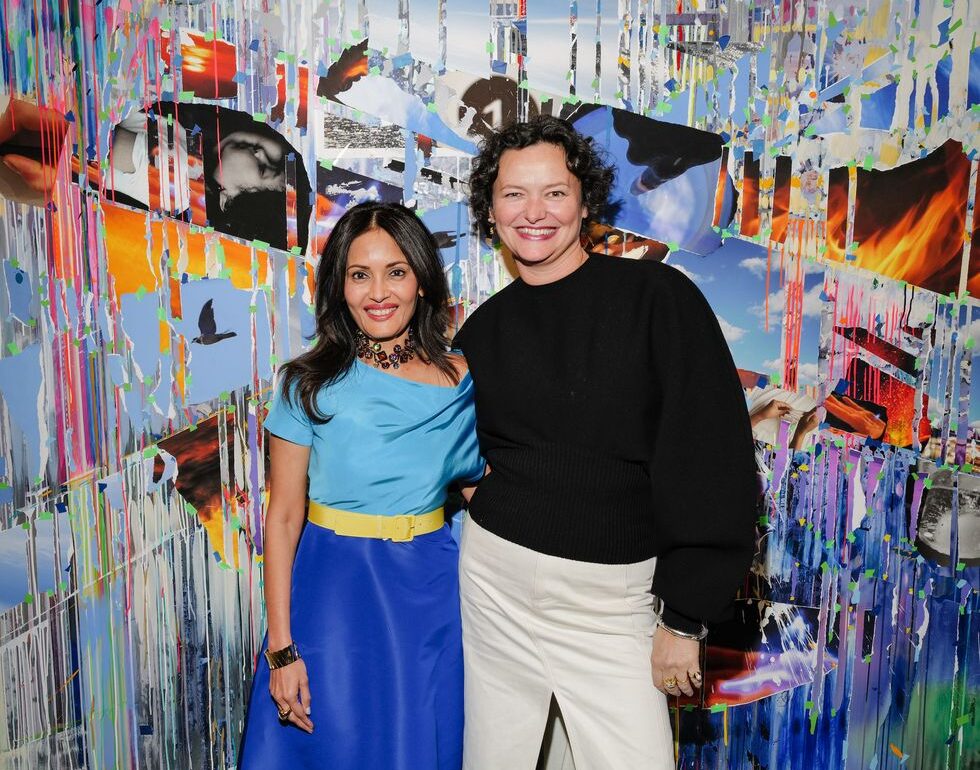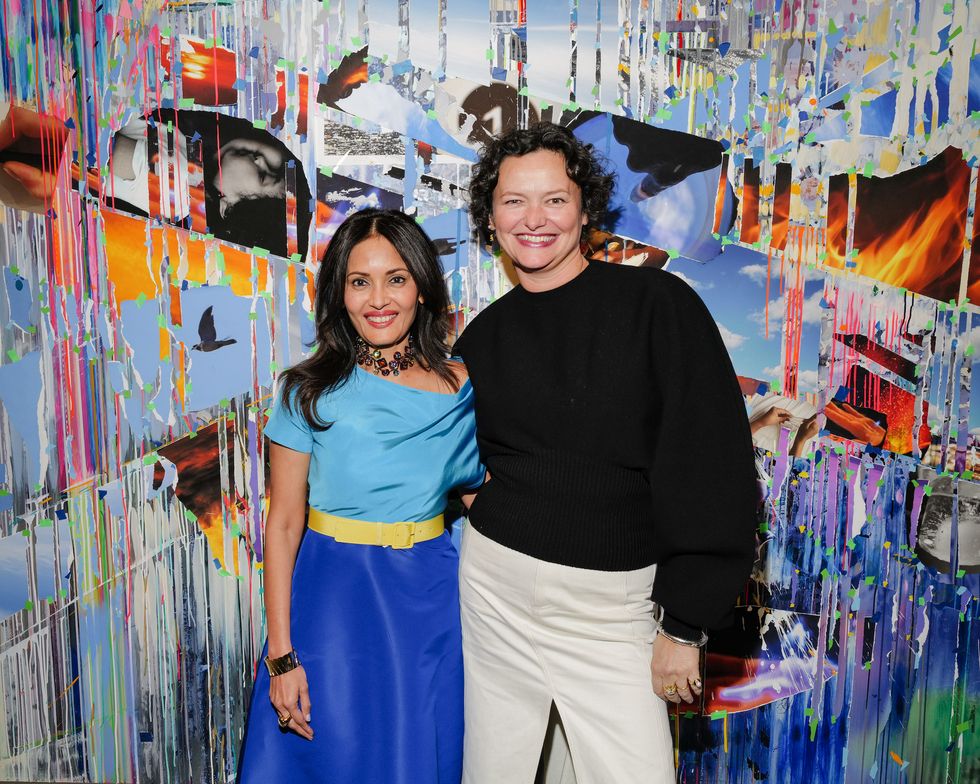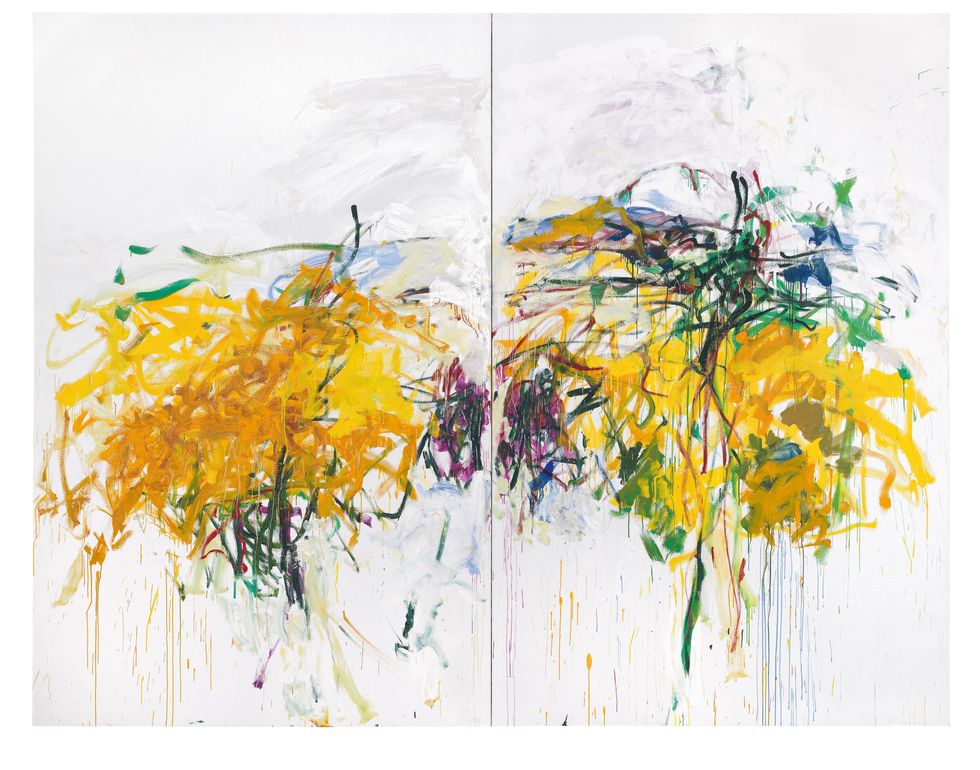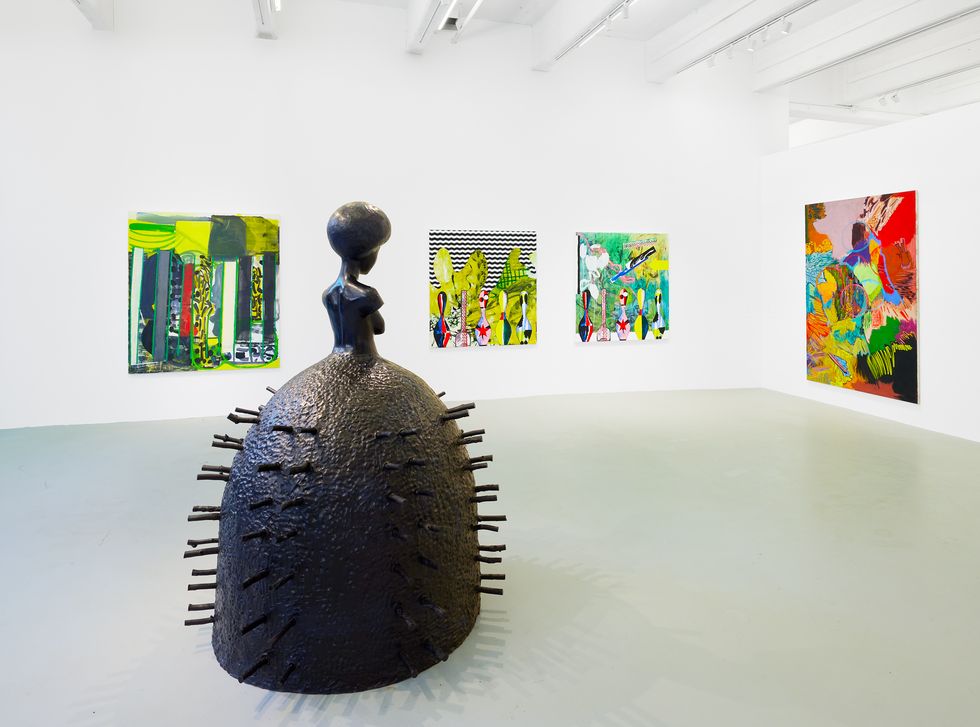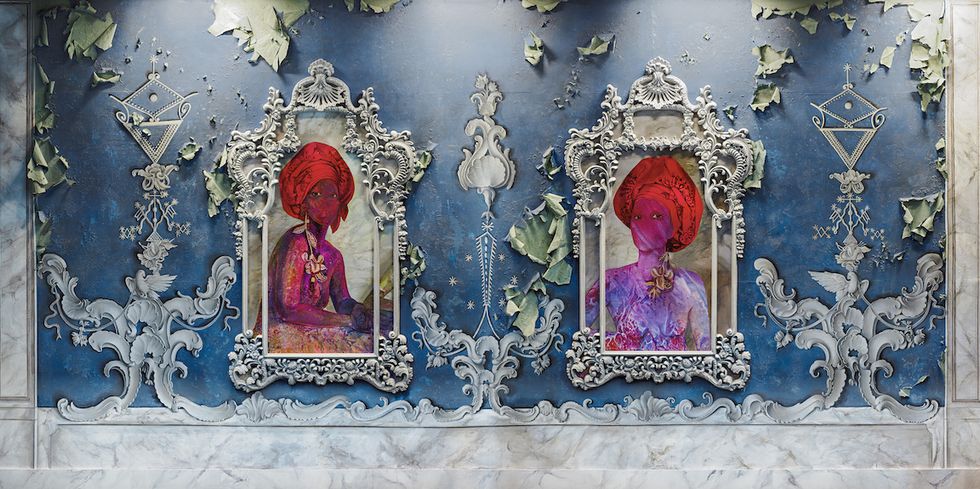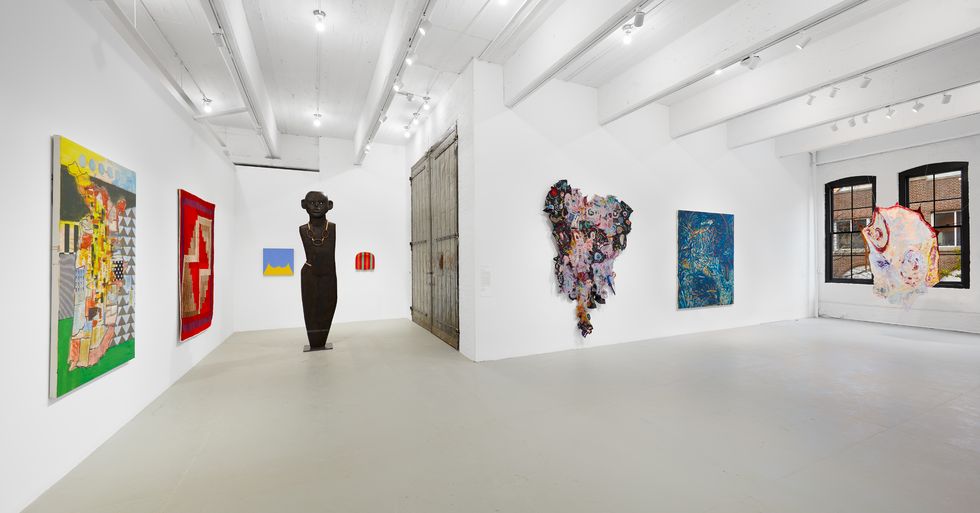During the 1940s and ’50s, influential critic Clement Greenberg helped catapult Jackson Pollock to art-world stardom with reverential reviews of the abstract expressionist’s innovative, action-based paintings. It wasn’t until 1961 that Greenberg revised his seminal 1955 essay “‘American-Type’ Painting,” to mention that in 1944, he and Pollock had, in fact, visited a gallery where they “admired” the “first really ‘all-over’” artworks they had seen, by self-taught Ukrainian-American artist Janet Sobel. “Pollock admitted that these pictures had made an impression on him,” wrote Greenberg. Yet, in the same breath that the critic acknowledged Sobel’s “strangely pleasing pictures,” he spited her as a “primitive” painter, just “a housewife living in Brooklyn.”
Sobel’s drip paintings, some of which are now included in MoMA’s permanent collection, are widely known to have predated Pollock’s—though like many women’s, her story has been left out of most history books. Now, a psychedelic painting by Sobel, circa 1946, which bears an uncanny resemblance to Pollock’s iconic canvases, greets visitors at “Making Their Mark,” a new exhibition featuring nearly 100 works by more than 80 artists from the jaw-dropping collection of tech executives and entrepreneurs Komal Shah and her husband, Gaurav Garg. The all-female show, which opened in November at Dia Chelsea’s former New York City gallery space, brilliantly reflects the California-based couple’s efforts to, as Shah puts it, “level the playing field in a world which has long been dominated by men.” Shah found a curator in her friend Cecilia Alemani, the Donald R. Mullen Jr. director and chief curator of High Line Art; as artistic director for the 2022 Venice Biennale, Alemani conceived an exhibition largely around avant-garde female artists.
Although a recent influx of texts and exhibitions have helped revive the stories of overlooked female artists, Shah and Alemani warn that such promotion must be more than a trend. “Centuries of distinction cannot be wiped away in a few years,” Shah says. In October, the National Museum of Women in the Arts in Washington, D.C., relaunched after a two-year, $70 million renovation, and the Smithsonian American Women’s History Museum disclosed more about its ambitious plans—though it is still a decade away from welcoming visitors. “If the needle moves in every museum from the 12 percent of work by women to 51 percent, then we won’t even need a museum dedicated to women. So until we go from 12 to 51, I’m going to have to keep working.”
For nearly a decade, Shah and Garg’s home has been a destination where artists, educators, and institutional leaders from around the globe can convene. The couple has lent works to countless museum shows, and published their first book, Making Their Mark: Art by Women in the Shah Garg Collection (edited by art historians Mark Godfrey and Katy Siegel), last May. Far from a mere vanity project, the tome is chock-full of scholarly writing on both established and undersung female artists, many of whom penned their own essays. Once the book was in motion, the next question Shah asked herself: “How will we make this collection accessible?”
And thus “Making Their Mark”—the exhibition—was born. Staged across two floors (the first focusing on abstraction, the second introducing figuration), the show contextualizes cutting-edge talents across genres with titans who have continued to pave the way for other artists, even posthumously. For example, just a week after the exhibition opened, the late Joan Mitchell (who died in 1992, and is one of only a handful of women whose works sell for eight-digit prices) broke her auction record with a painting that sold at Christie’s for nearly $30 million.
One of the most important works on view in “Making Their Mark” is Mitchell’s 1992 painting Untitled, recently featured in Fondation Louis Vuitton’s “Monet – Mitchell” exhibition. “If I were a student, I would come to see the show just to see that painting,” says Alemani, who conceived Shah’s exhibition “as a dialogue between generations of artists and mentors, or between artists whose works resonate with one another.” The first full gallery at “Making Their Mark” packs a punch, putting Mitchell’s masterpiece in conversation with two equally explosive and vibrant works: an astounding 24-foot-wide painting from 2021 by Los Angeles–based contemporary artist Mary Weatherford, and a five-foot-wide spray-painted canvas by New York artist Julie Mehretu from 2020 to 2022.
“I love scale. I like muscularity. I like textiles. I like everything. You can see that the collection itself has a visual voice, but it is very much spontaneous,” says Shah, who was born in Ahmedabad, India, a city designers like Oscar de la Renta and Naeem Khan have long flocked to for exquisitely crafted embellished fabrics. She grew increasingly passionate about fine art after moving to the United States in 1991 to study computer science at Stanford (one of three women in her class of 100) and meeting Garg, who would share his love of abstract expressionism with her.
Shah was inspired to pursue collecting more seriously after visiting the 2014 Whitney Biennial, where abstract works by contemporary artists Jacqueline Humphries, Charline von Heyl, and Amy Sillman captivated her. “I started spending time with these artists, reading and learning about them, and chasing their networks of influence,” she says, calling these “incredibly smart, spunky, and funny” women “the core of [her] collection.” “When I do a studio visit and meet a great artist, I will walk on water for some time after. There’s nothing better than just seeing creativity without any boundaries. It is supremely uplifting.”
Shah’s patronage has proven mutually beneficial. “Komal makes this personal commitment to being a public model for an outspoken vision in collecting,” says visual artist Sillman, “but she is also genuinely interested in and curious about what we’re up to on a more intimate level, knowing what we’re looking at, who we’re talking to, and being supportive of our lives as artists.”
Known for her large-scale, often graphic, nude portraits, 91-year-old Joan Semmel is another key artist in Shah’s collection. In the 1970s, when galleries refused to show Semmel’s Erotic Series, she exhibited the works herself. “To see women from all levels of being known, and to see how the strength of the work has held up over generations, is very exciting and moving for me,” she says of Shah’s exhibition. Her 10-foot painting Horizons (1981), which depicts the artist’s naked body both realistically and expressionistically, is aptly placed near fellow feminist Judy Chicago’s small dome sculptures. “I feel that those years of fighting so hard for a foothold were worth it,” Semmel says. “It was something that we did out of our own necessity and conviction, and it’s come to this beautiful fruition.”
Another must-see (and, at 21 feet, can’t-miss) work is Dominican Republic–born Firelei Báez’s For Améthyste and Athénaïre (Exiled Muses Beyond Jean Luc Nancy’s Canon), Anacaonas. Commissioned for MoMA’s West 53rd Street window, where it was exhibited from 2018 to 2019, the work resembles an ornately decorated blue wall, surrounded by marble architecture. In the center of two wooden frames are Améthyste and Athénaïre Christophe, daughters of the first and only king and queen of Haiti, who witnessed the Caribbean country gaining its independence from France. “The fact that that piece is in Komal’s collection and not in MoMA’s tells you a lot,” Alemani says. “It also shows how she is not afraid of buying works that clearly are not going to fit in her house.”
Acting as a bridge between the exhibit’s predominantly two-dimensional figurative art and its textile works is Françoise Grossen’s Contact III (1977), an orange suspended rope sculpture exceeding 30 feet. Playing with surrealism and minimalism, the work loosely evokes a line of pom-pom-headed people holding hands. “This surprising piece was selected as a statement to elevate a kind of art that has often been considered secondary. It points a finger to the idea that women were expected to only make small pieces,” says Alemani, who prior to the show had never heard of the 80-year-old Swiss-American Grossen.
While Shah’s collection feels balanced with its distinctive combination of media, that wasn’t always the case. “The first five or six years, the collection was focused on painting and sculpture with big, muscular gestures,” says Shah. “In talking to Katy [Siegel], I realized that the people who’ve made rules around fine art were all men, and I began questioning the rubric by bringing in textiles, ceramics, and works deemed ‘craft.’”
The final gallery of the exhibition brings together quilts by Black artists, including Faith Ringgold, Elizabeth Talford Scott, and her daughter, Joyce J. Scott, and an “altarpiece,” as Shah describes it, presenting ceramics and sculpture by a diverse range of makers. “One of the qualities that I admire most about Komal is her openness and curiosity for discovering works outside of the art world’s trends or blue-chip tendencies,” Alemani says. For example, the curator says, late Japanese-American artist Toshiko Takaezu is like “an AbEx painter in ceramics” who “should be contextualized among Mitchell and Rothko.” Other standouts of the show include hanging works by 97-year-old Californian fiber-based artist Kay Sekimachi (whose 1965 sculpture, composed of intricately woven nylon monofilament, Alemani calls “strikingly contemporary and futuristic”) and her late mentor Trude Guermonprez.
After “Making Their Mark” closes in New York in January, it will travel to California’s Berkeley Art Museum and Pacific Film Archive in September 2024, followed by the Kemper Art Museum in St. Louis in 2025. In the longer term, Shah envisions a permanent institute that provides “a living, breathing space for discourse, educational programming, and amazing shows.” While her exhibition has already garnered attention from the art and fashion spheres (Dior’s artist-championing creative director, Maria Grazia Chiuri, was its first visitor), her work is far from over. “Having dozens of artists come to the show and be giddy when they see their works on the walls makes me feel better and better about what I’m doing,” the collector says. “To feel I’ve made a slight contribution to the art world and their lives inspires me to keep going.”
This post was originally published on this site be sure to check out more of their content.




